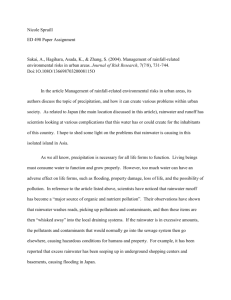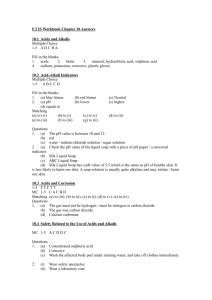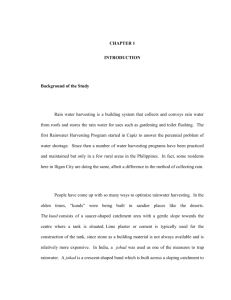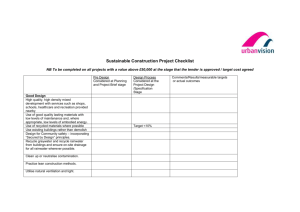How Acidic Is Your Rainwater?
advertisement
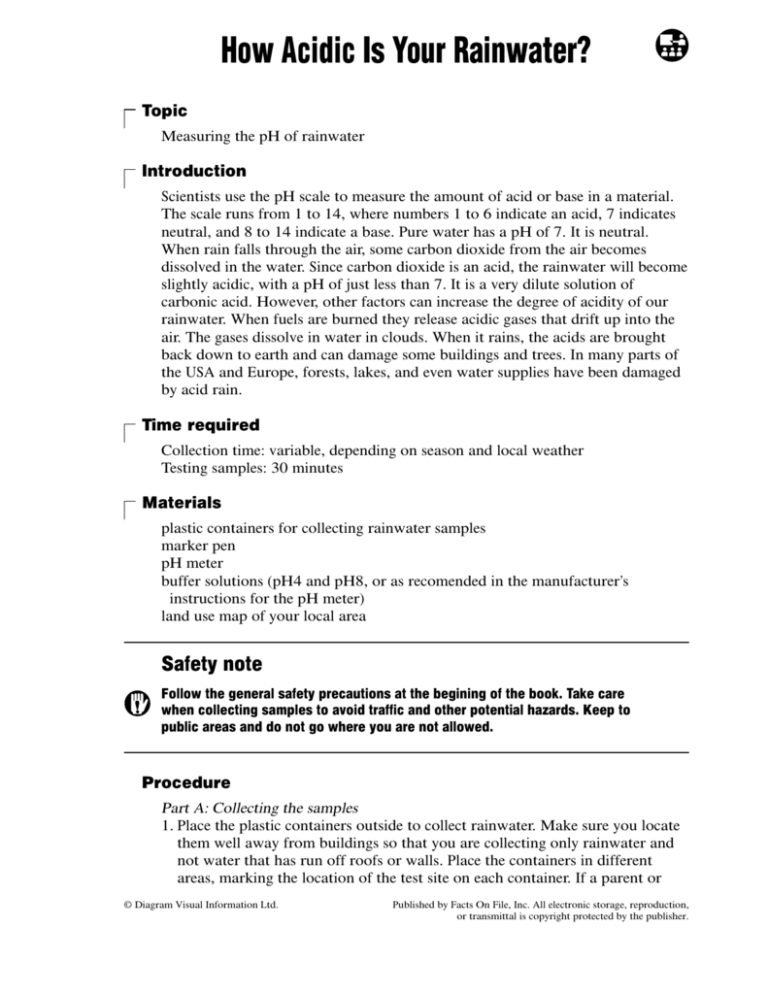
How Acidic Is Your Rainwater? Topic Measuring the pH of rainwater Introduction Scientists use the pH scale to measure the amount of acid or base in a material. The scale runs from 1 to 14, where numbers 1 to 6 indicate an acid, 7 indicates neutral, and 8 to 14 indicate a base. Pure water has a pH of 7. It is neutral. When rain falls through the air, some carbon dioxide from the air becomes dissolved in the water. Since carbon dioxide is an acid, the rainwater will become slightly acidic, with a pH of just less than 7. It is a very dilute solution of carbonic acid. However, other factors can increase the degree of acidity of our rainwater. When fuels are burned they release acidic gases that drift up into the air. The gases dissolve in water in clouds. When it rains, the acids are brought back down to earth and can damage some buildings and trees. In many parts of the USA and Europe, forests, lakes, and even water supplies have been damaged by acid rain. Time required Collection time: variable, depending on season and local weather Testing samples: 30 minutes Materials plastic containers for collecting rainwater samples marker pen pH meter buffer solutions (pH4 and pH8, or as recomended in the manufacturer’s instructions for the pH meter) land use map of your local area Safety note Follow the general safety precautions at the begining of the book. Take care when collecting samples to avoid traffic and other potential hazards. Keep to public areas and do not go where you are not allowed. Procedure Part A: Collecting the samples 1. Place the plastic containers outside to collect rainwater. Make sure you locate them well away from buildings so that you are collecting only rainwater and not water that has run off roofs or walls. Place the containers in different areas, marking the location of the test site on each container. If a parent or © Diagram Visual Information Ltd. Published by Facts On File, Inc. All electronic storage, reproduction, or transmittal is copyright protected by the publisher. teacher can assist with transportation, try to spread your test sites over a fairly wide area. Interesting test sites could include a school or public playground; a site near a busy road; the middle of a large park; farmland or open country on the upwind and downwind sides of town; sites upwind and downwind of a large industrial area; the city center; an outer suburb. Part B: Testing the samples 1. Collect the plastic containers of rainwater and bring them into the lab. 2. Set up the pH meter following the setting-up procedure provided in the manufacturer’s instructions. You will use the buffer solutions to calibrate the meter, but the process will vary depending on which make and model of meter you are using. 3. Enter the location of your first test sample in the data table. 4. Place the pH probe into the rainwater sample. Wait until the meter reading has steadied, and record the pH value in the data table below. 5. Repeat the test with each of your samples. 6. Plot the pH values of your test sites on a land use map of the local area. 7. Repeat the experiment at different times of the year. D ATA Location of sampling site TABLE Rainwater pH Analysis 1. What do the pH values tell you about the acidity of your rainwater? 2. If your rainwater is acidic, what do you think has caused it? 3. Is there any variation in pH between the samples you have tested from different areas? If there is, do the results of plotting the collection sites on a land use map provide any clues about the possible reasons for the variation? 4. If you repeat the experiment at different times of year, do your results show any variation? If they do, can you explain them? 5. Do some research, and find out more about the causes of acid rain, what effects acid rain has on the environment, and what is being done about it. Want to know more? Click here to view our findings. © Diagram Visual Information Ltd. Published by Facts On File, Inc. All electronic storage, reproduction, or transmittal is copyright protected by the publisher. 3.04 How Acidic Is Your Rainwater? 1. Rainwater is acidic because carbon dioxide from the air is dissolved in it. This would give a pH of around 6.0–5.5. If the pH of the water is less than this value, there is probably some other acidic gas dissolved in the rainwater. 2. When fossil fuels (coal, natural gas, petroleum) are burned, carbon dioxide is produced. Most fossil fuels contain sulfur as an impurity, which produces sulfur dioxide gas when burned. The gases produced will react with water to form carbonic acid and sulfurous acid, as shown in the equations below: CO2 + H2O → H2CO3 SO2 + H2O → H2SO3 The main sources of these gases are power stations burning coal or oil. Automobile engines also produce acidic gases. The exhaust gases contain carbon dioxide and nitrogen oxides, which form nitric acid in water as shown in the following equation: NOx + H2O → HNO3 3. Look at the map for indications of industrial land use. What kind of industries are located there? Do they have big smoke stacks? Which way does the wind normally blow? How do these factors relate to the pH values you found? 4. Acid rain has many effects on the environment. It will react with metal structures and buildings, particularly those constructed from limestone. Trees can be damaged or even killed. Aluminum, which is normally stored in the soil, will react with acid rain and be washed into rivers or lakes where it can kill fish and other aquatic animals.
